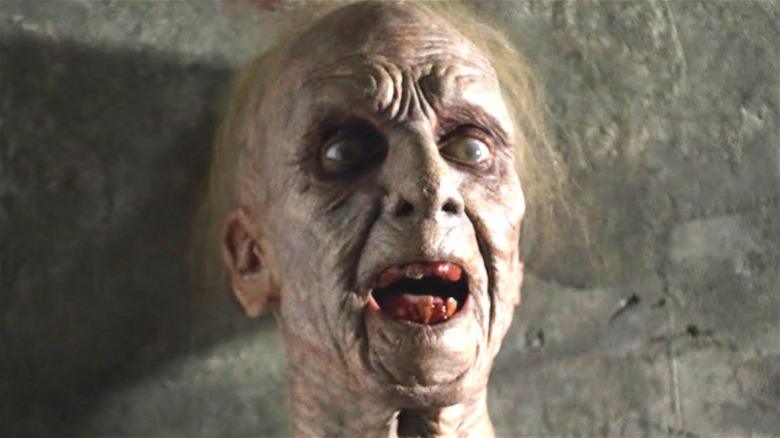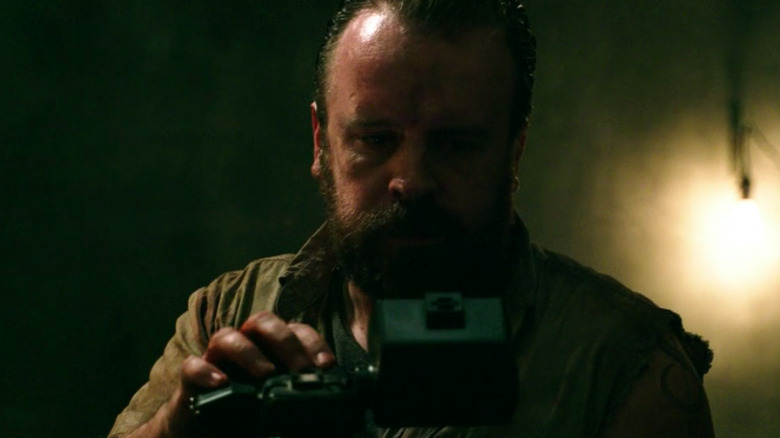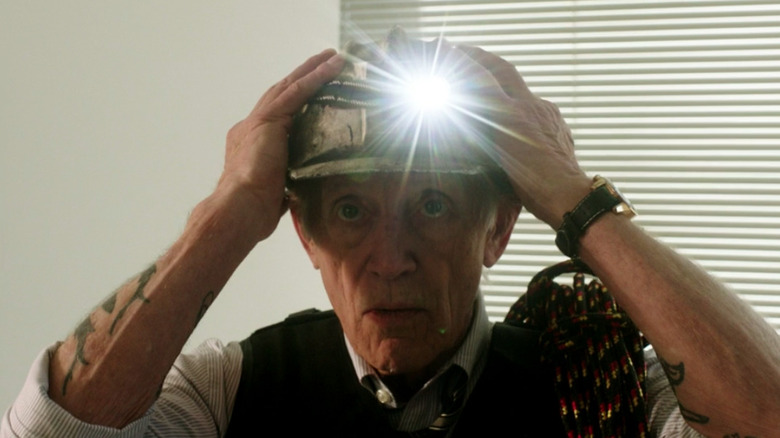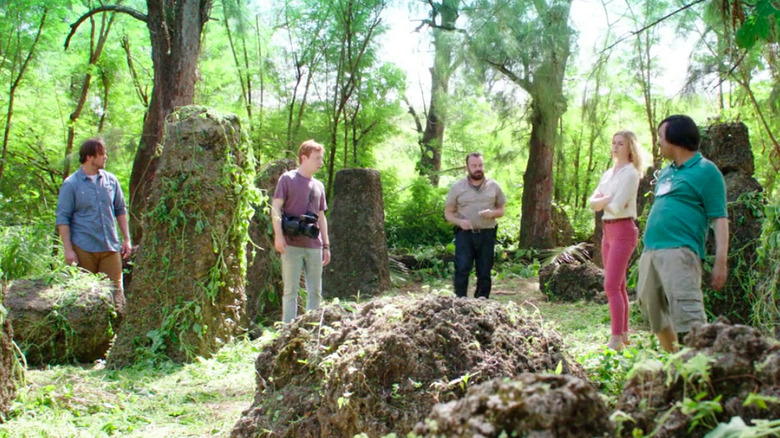The Ending Of Gehenna: Where Death Lives Explained
"... it is better for you to enter into life with one eye, rather than having two eyes, be cast into Gehenna," reads the opening title card of the 2016 American-Japanese horror film "Gehenna: Where Death Lives."
Luxury resort scouts Paulina (Eve Swan), Tyler (Justin Gordon), and Dave (Matthew Edward Hegstrom), led by their location coordinator Alan (Simon Phillips), and his assistant Pepe (Sean Sprawling), stumble into a World War II bunker nestled in a forest on the remote island of Saipan. The bunker was occupied by violent Japanese troops during the war, and before that, it was occupied by Spanish colonizers who brutalized the Chamorro people. The locals consider it a sacred but cursed place.
The whole "white Americans trampling through sacred indigenous burial grounds" to them "being afflicted by a curse" pipeline has been explored in the horror genre before, but Hiroshi Katagiri's directorial debut adds two last-minute twists. By the end, Paulina and Tyler realize that "only one" will live — and not in the way they were thinking. They die before the homicidal Alan figures it out, leaving him trapped in the ghost-laden bunker for eternity.
Despite receiving mostly negative reviews, the film won Best Cinematography for a Feature Film at Chicago Indie Horror Film Festival in 2017 and was praised for Katagiri's FX prowess (via IMDb). Most of the criticism has been targeted toward the confusing plot, so let's unpack it.
The rules of Gehenna: Where Death Lives
"Only one can live ... torment to all ... witness for eternity ... torment for eternity," Paulina shakily translates from the messages scrawled on the cavernous walls. The characters revisit this message throughout the film, dismissing it as ancient folklore. However, this was the curse they'd soon fall victim to.
Dave recognizes the accompanying drawings from a book he read on Chamorro folklore. He explains that the first Bojobo dolls held the spirits of an ancient chief and his bride who shared an eternal bond. In death, they were separated and the curse was formed. "The chiefs' suffering for his lost love would be equally eternal and that torment would be felt ..." he says.
The group focuses on the "only one can live" statement, which prompts Alan to attack Tyler, Pepe, and Paulina. He believes that being the last man standing will free him from the curse and the bunker. It's not until Tyler, with his last breath, laughs and says, "If you live, you lose. You lose worst of all."
Alan then realizes that they were never going to escape the bunker. They cannot die unless someone witnesses their passing and replaces them as the eternal witness to the horrors of Gehenna, meaning the sole survivor cannot die unless someone new enters the bunker.
The end of the movie also reveals that the fluidity of time forces Alan to keep repeating the incident without being able to prevent it — he was the ominous skeletal man all along. Unless, of course, the post-credits scene has anything to do with what happens next.
What does the post-credits scene mean?
Alan's fate in Gehenna may not be as eternal as the ending of the film might suggest. After the credits roll, there is a brief scene where a tattooed older man is gearing up. His supplies include a tactical vest, a handgun, rope, and a mining helmet. "Paulina? I'm coming for you," he proclaims as the camera cuts to black. "Taxi!"
Morgan (Lance Henriksen) is Paulina's boss, who appears to be heading to Saipan to find her. But will Henriksen, a legendary horror and science-fiction actor, be returning for a sequel? In an interview with AIPT comics, producer Saik Meng Kee explained that the plan was to make a direct sequel to "Gehenna: Where Death Lives" as a VR game rather than a movie.
"You can hear footsteps running around you 360 degrees, you will frantically shine your torchlight around in the darkness, you can hear somebody breathing onto the back of your neck, and when you turn around, you may find a pair of eyes staring straight into your eyes," he told the outlet.
"Gehenna: Death Memories" is a VR game based on the movie in which the player wakes up in the bunker and must try to escape the bunker, the curse, the undead, and haunting visions (via VR Explorer).
The real-life lore that inspired Gehenna: Where Death Lives
Kee described the film's lore to AIPT Comics as "a dark world in the World War II cave-bunker with a deep mythology that spans all the way back to witchcraft during the Spanish Inquisition."
Previously, Saipan had been occupied by Spain, Germany, and Japan and is currently a commonwealth of the United States. Katagiri told AIPT Comics that he was inspired by the "horrible history" of Saipan and chose to focus on their "grudge against the Spanish creating the curse."
"Gehenna: Where Death Lives" is hardly a commentary on colonialism, but much of its horror derives from the real tragedies the Chamorro people lived through. In an interview with Horror Fuel, Katagiri said that he was also inspired by Saipan legends like the Taotao'mon god, the Bojobo dolls, and the latte stones. "I used the real story but turned it into horror," he said.
However, not all viewers appreciated the historical references. "As a Chamorro myself the movie was absolute garbage," said CHAIFE671 on a horror subreddit. "There's not a whole lot of cultural representation of the Chamorro people but it seems like the guy who wrote the story for this heard the legend [of Taotao'mona] and decided to make a mockery of it."



